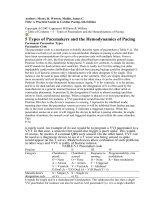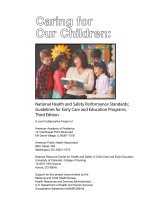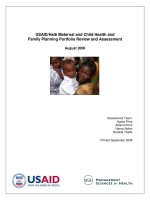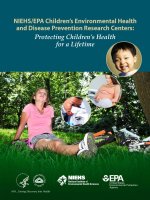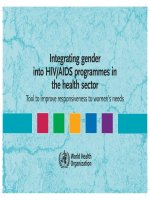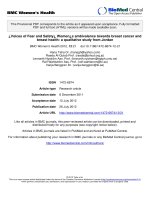Tài liệu Integrating Youth-Friendly Sexual and Reproductive Health Services in Public Health Facilities: A Success Story and Lessons Learned in Tanzania ppt
Bạn đang xem bản rút gọn của tài liệu. Xem và tải ngay bản đầy đủ của tài liệu tại đây (324.06 KB, 17 trang )
Integrating Youth-Friendly Sexual and
Reproductive Health Services in Public
Health Facilities: A Success Story and
Lessons Learned in Tanzania
November 2005
Acknowledgements
Pathfinder International Tanzania wishes to acknowledge key players who were involved in
planning and implementation of the African Youth Alliance (AYA) project. First, we would to
thank the government of Tanzania, who was an AYA key collaborator and host, especially the
President’s Office - Planning and Privatization, and the Ministries of Health, Mainland and
Zanzibar. The following were implementing partners of AYA/Pathfinder:
• Reproductive and Child Health Section (RCHS) – Ministry of Health Mainland
• Safe Motherhood Program – Ministry of Health Zanzibar
• Municipal and district councils: Ilala, Temeke, Kinondoni, Arusha, Kasulu, Kibondo, Tarime,
Karagwe, Unguja and Pemba Island.
• Marie Stopes Tanzania
• The Family Planning Association of Tanzania (UMATI)
• University of Dar es Salaam
• Infectious Disease Centre (IDC) in Dar es Salaam
Special thanks go to Dr. Chalamilla and his staff for making it possible to use the IDC clinic as a
learning model for improving services in the public sector.
Sincere thanks go to Mr. Silvery Buberwa, director of Social Services and Human Resources,
President’s Office - Planning and Privatization; Dr Catherine Sanga, head of RCHS; Dr. Hanun –
head of the Safe Motherhood Program; Dr. Elizabeth Mapella, adolescent reproductive health
information, education and communication officer, RCHS; Dr. Mtasiwa, city medical officer, Dar
es Salaam; Dr. Laizer, municipal medical officer, Arusha; Dr. Frank Eetaama –Tarime; Dr.
Rutahinurwa –Karagwe; Dr. Bangi –Kasulu; Dr. Kajuna – Kibondo; Dr. Kahama – Ilala; Dr.
Beatrice Byarugabe- Kinondoni; and Dr. Louisa Masanyika-Temeke.
Many thanks go to the AYA/Pathfinder Tanzania team, led by Naomy Achimpota and
including Paul Luchemba, Oswald Malunda and Michael Machaku, for their work in collecting
information and contributing technically to this document.
AYA Country Coordinator Halima Shariff is acknowledged for sharing contributions made by the
district AYA coordinators in facilitating integration of AYA activities in their district
development plans.
Shyam Thapa (Family Health International), Palena Neale (Pathfinder International
headquarters), and Emmanuel Boadi (AYA/Pathfinder Ghana) are acknowledged for their
contributions into the planning of this case study.
Carolyn Boyce and Gwyn Hainsworth of Pathfinder International headquarters are also
acknowledged for their technical assistance in the finalization of this documentation.
Special thanks go to consultant Cuthbert Maendaenda, who wrote this case study.
Nelson Keyonzo
Country Representative
Pathfinder International
Tanzania Office
i
About the African Youth Alliance Project
The African Youth Alliance (AYA) was an initiative implemented in Botswana, Ghana,
Tanzania and Uganda. The five year project (2000 – 2005) was supported by the Bill and
Melinda Gates Foundation and executed in partnership by the United Nations Population
Fund (UNFPA), Pathfinder International, and the Program for Appropriate Technology in
Health (PATH). The three partner agencies provided technical and financial support to
strategically identified implementing partners. AYA also collaborated closely with respective
governments in operationalizing and coordinating its project activities. The main aim of AYA
was to improve overall sexual and reproductive health of youth aged 10-24 years and reduce
the incidence of HIV/AIDS and other sexually transmitted infections.
The AYA project had six major component areas. Each partner agency supported two of
these as follows: Youth-Friendly Services (YFS) and institutional capacity building
(Pathfinder International); policy and advocacy, and coordination and dissemination
(UNFPA); and behavior change communication and life and livelihood skills (PATH).
In Tanzania, the AYA initiative was established in 2001 and was implemented in 10
strategically-selected districts, targeting 1.2 million youth between 10 and 24 years of age in
both urban and rural areas. Parents and policymakers were among secondary and tertiary
beneficiaries of AYA in the country. The project sites in mainland Tanzania were the districts
of Tarime, Karagwe, Kasulu, and Kibondo and the municipalities of Arusha, and Ilala,
Temeke and Kinondoni in Dar es Salaam. In addition, the project was implemented in the
Urban West region and Pemba Island, in Zanzibar.
The objective of the YFS component was to increase the use of quality, youth-friendly
adolescent sexual and reproductive health services. The intermediate results from the
component were as follows:
• Availability of quality YFS in the project districts increased
• Supportive environment for YFS provision increased
• Demand for YFS services increased
• Monitoring and supervision of YFS for clinic and outreach activities established
• Competence of facilities to deliver and sustain quality YFS activities improved
ii
Introduction
Lack of accessibility to Sexual and Reproductive Health (SRH) information and services by
young people is a problem that needs serious attention by program planners and service
providers. Despite an increasing number of reports on youth SRH problems, the SRH needs
of young people often fall through the cracks of many health and development plans and
programs.
Because of the stigma attached to adolescent sexuality, there have been pockets of opposition
to youth access to SRH information and services for fear of promoting promiscuity among
the age group. For that reason, there have been few efforts by policymakers, government
leaders, and SRH service providers to promote provision of youth-friendly SRH services. As
a result of that lapse, there has been a feeling by SRH stakeholders that such services can
only be provided by Non-Governmental Organizations (NGOs), rather than through the
public health delivery system.
However, public health facilities have great potential for scaling-up and sustaining youth-
friendly SRH services due to a variety of reasons, foremost of which is that these facilities
already exist and are more likely than NGO facilities to exist in the future. This document is
intended to share successes and lessons learned from integrating Youth-Friendly Services
(YFS) into public health facilities.
Methodology
Data and information for this case study was collected through the review of existing
documents, through interviews with AYA project staff, Ministry of Health representatives,
and YFS and district coordinators, and through field visits. Documents reviewed included
the following project reports: quarterly, annual, implementing partner quarterly (including
achievement charts), and facility assessment reports. Interviewees included four AYA project
staff (country coordinator, YFS program technical officer, YFS program associate, and the
institutional capacity building technical officer) and two Ministry of Health representatives
(information, education, and communication/adolescent sexual and reproductive health
coordinator of reproductive and child health section of Dar and the AYA/YFS coordinator of
the safe motherhood programme of Zanzibar). In addition, field visits and interviews with
YFS and district coordinators occurred in Ilala, Temeke and Kinondoni. Data was collected
and analyzed from March to April 2005.
The Problem
Young people in Tanzania are at risk for a broad range of health problems. Among these
problems are early sexual debut, unwanted pregnancies, unsafe abortion, pregnancy-related
complications, Sexually Transmitted Infections (STIs) and HIV/AIDS. Youth are especially
vulnerable to these problems because they are more likely to engage in unplanned and
unprotected sex, they lack the skills necessary to negotiate for safer sex, they engage in
sexual activity with multiple partners, and they have limited awareness of STI prevention.
Furthermore, Tanzanian youth have typically found it difficult to access reproductive health
and HIV/AIDS services because most facilities are not youth friendly and are generally
1
geared toward adults.
1
To make matters worse, young people commonly have little or no
money, are without transportation, have a lack awareness of available services, are restricted
from seeking sexual and reproductive health services, and fear being stigmatized by adults
who may see their behavior as irresponsible and their presence in a clinic as a possible
indication of sexual activity.
Family planning and reproductive health services have been provided as part of maternal and
child health services in Tanzanian public health facilities since their introduction in 1974.
This has led to the perception of the community that SRH services are for adult women
thereby creating barriers to access for both men and youth.
In addition, negative attitudes and lack of information about youth sexuality have resulted in
the failure of most Tanzanian SRH service providers to provide YFS. It should be noted that
YFS is not included in the pre-service training that health staff receive at training institutions.
Although the Tanzanian National Policy Guidelines for Reproductive Health and Child
Health Services (2003) support young people’s access to SRH information and services, there
are many gaps in its implementation. Due to fears of community opposition, the government
had been willing to let NGOs take the lead in providing SRH information and services to
young people. However, the majority of Tanzanians (nearly 80 percent) live in rural areas,
where there are few NGOs that have the capacity to run district-wide interventions. Most of
the NGO-run youth SRH programs are urban-based and donor dependent, making them less
sustainable than public health facilities
Because of past reliance on NGOs for the provision of YFS, the government system did not
have an adolescent health and development strategy. There was no standardized training for
YFS, nor any YFS service delivery standards and guidelines. At the district and council
levels, YFS was not a priority and therefore not part of the comprehensive health or
development plans.
Steps taken to address the problem
Despite the challenges of instituting YFS service provision at government facilities as
described above, it was believed that the government facilities would be the best poised to
offer and sustain services for youth. The government has a very extensive network of public
health facilities throughout the country with qualified service providers, and given that those
health facilities are covered within government budgets, there is a very high likelihood of
sustaining services once established. Therefore, AYA decided to work within the government
health system in an attempt to establish sustainable quality, youth-friendly SRH services that
would be available to a larger percentage of the youth population.
At the beginning, the government of Tanzania requested a Memorandum of Understanding
(MOU) from the AYA partners. Although the government was involved in writing the initial
AYA proposal, an MOU was critical to clarify the mechanisms for distributing AYA funding
within the country. Several consultative meetings with government officials were conducted
to produce a MOU that clarified roles and responsibilities and to ensure harmony and
understanding of the operational modalities of AYA. On September 5, 2000, a stakeholders’
1
AYA/Pathfinder (2003). Youth-Friendly Sexual and Reproductive Health Services: An Assessment of
Facilities. Pathfinder International: Watertown, MA.
2
meeting was conducted in Zanzibar and on September 12 a meeting was held in Dar es
Salaam to discuss the implementation of the AYA project in Tanzania. The final MOU draft,
in consultation with five government ministries, was finalized by the end of the year.
In collaboration with the National Reproductive and Child Health Section of the Ministry of
Health (RCHS) in the mainland and the safe motherhood program of Ministry of Health in
Zanzibar, AYA aimed to achieve the following:
• Increase sustainable outlets of quality YFS in the districts
• Obtain government commitment and support in provision of YFS in the districts
• Demonstrate that public health facilities can equally provide quality YFS and in a
more sustainable manner than NGOs
• Increase collaboration among government, NGO, and private organizations in
promoting YFS
The first round of implementing partners were comprised of two leading reproductive health
NGOs (Marie Stopes Tanzania and Umati), the University of Dar es Salaam, and the
Infectious Disease Center. Pathfinder subsequently provided subgrants to ten individual
AYA districts: Kinondoni, Temeke, Ilala, Kasulu, Zanzibar, Kibondo, Arusha, Karagwe, and
Tarime. As a result, AYA worked with 58 facilities across the country, including 44 public
facilities. The following diagram illustrates the framework of Tanzania’s YFS intervention:
FACILITY
ASSESSMENT
ACTION
PLAN
SERVICE
QUALITY
PRE - SERVICE
FACILITY
STRENGHTENING
TRAINING OF LAY
COMMUNITY &
STAKEHOLDER
MOBILIZATION
TRAINING OF
SERVICE
PROVIDERS
TRAINING OF
SUPERVISORS
CLIENTS
•
Counseling
•
Services
•
Behavior
INPUTS
INPUTS
OUTPUTS
OUTPUTS
EFFECTS
EFFECTS
STANDARDIZATION
OF CURRICULUM &
GUIDELINES
ALL STAFF
ORIENTATION
M&E
DEVELOPMENT OF
TOOLS, MIS &
FEEDBACK FORMS
FACILITY
ASSESSMENT
ACTION
PLAN
SERVICE
QUALITY
IMPROVEMENT
- PRE-SERVICE
TRAINING
FACILITY
STRENGHTENING
TRAINING OF
OUTREACH STAFF
TRAINING OF LAY
COUNSELORS
COMMUNITY &
STAKEHOLDER
MOBILIZATION
TRAINING OF
SERVICE
PROVIDERS
TRAINING OF
SUPERVISORS
CLIENTS
•
Counseling
•
Services
•
Behavior
INPUTS
INPUTS
OUTPUTS
OUTPUTS
EFFECTS
EFFECTS
DEVELOPMENT OF
IN-SERVUCE
CURRICULUM AND
GUIDELINES
ALL STAFF
ORIENTATION
DEVELOPMENT OF
TOOLS, MIS &
FEEDBACK FORMS
As shown above, the following key activities were undertaken under AYA:
• Facility assessments for YFS integration were undertaken in each facility.
Assessment teams were comprised of selected service providers and youth. Findings
3
were shared with service providers and management of each facility to ensure their
buy-in and support for the effort. The feedback contributed to development of YFS
action plans for facility-strengthening efforts.
• City and municipal authorities were sensitized on unmet SRH needs of youth and the
rationale for government involvement and support.
• Doctors and nurses involved in provision of SRH were trained on YFS and
participated fully in the facility assessment. Their participation helped them assess
and identify gaps in the quality of the services being offered to youth. Supervisors,
lay counselors, and other facility staff also received training on YFS to support the
facility efforts.
• Peer service providers were trained to provide SRH information and contraceptives to
their peers to complement and create demand for facility services.
• AYA also worked to develop monitoring and evaluation tools and systems, and to
build staff capacity in this area.
Achievements
Although some AYA districts had less than two years of YFS implementation in Tanzania,
numerous significant achievements have been made by the project at the national level,
including:
• Increased awareness of the rationale and need for YFS provision, especially by
public health facilities, and among Council Health Management Teams (CHMTs) and
service providers. During field visits, staff from almost all of the sites expressed
concern regarding the end of AYA project funding at the time that public health
facilities are becoming known as a reliable source for YFS.
• The AYA project has led to strengthened capacity for national-level coordination of
YFS. AYA project funds supported staff to coordinate YFS, provided vehicles to the
Ministry of Health in the mainland and Zanzibar, and covered other YFS-related
expenses. AYA also supported the strengthening of provider supervision through
training and the introduction of supervision tools.
• In Zanzibar, there was provision of services to youth where existing policy does not
yet stipulate support for such access. Although Zanzibar policy prohibits service
provision of SRH needs to unmarried youth, in collaboration with the safe
motherhood program of the Ministry of Health in the Island, AYA integrated youth-
friendly SRH services were made available in selected public health facilities. AYA
began its efforts by providing services to youth attending MCH clinics for antenatal
care or family planning, and as a result of both the training and experience of service
providers in youth issues, as well as demand for the services by youth, service
provision to the group has expanded. This development has increased advocacy
efforts for the adolescent sexual and reproductive health rights that AYA and other
programs have been promoting. It is anticipated that this positive development will
also influence the review of the policy that prohibits unmarried youth from accessing
SRH services.
4
• In the mainland, through its RCHS, the Ministry of Health has developed YFS
training manuals for health providers, peer service providers and paramedical
counselors, including a training of trainers guide. In collaboration with the College of
Health Sciences, the Ministry of Health in Zanzibar now includes YFS as part of the
practical training requirement for pre-service health staff.
• Numerous youth-friendly facility strengthening efforts were accomplished over the
course of the project. Renovations of the facilities were done to make them attractive
and create special rooms for serving youth. In some facilities, youth have their own
waiting and consulting rooms equipped with television, video, newspapers, and
behavior change communication materials, providing added privacy for youth. In fact,
as a result of its facility assessment, and with their own funding, the clinic in Kasulu
split one room into four to better serve youth and to guarantee the privacy that youth
visits require. Clinics changed their hours to allow for better youth access and have
improved advertising of YFS through the erection of signposts outside their facilities.
A billboard at Kayanga Rural Health Centre in Karagwe advertises integrated youth-friendly
SRH services that are available at the center. Youth and health service providers perceived
this as a historical development in making SRH services accessible to youth in the
community.
• Monitoring and evaluation tools and systems were developed and used under AYA
to improve the facilities. Youth were trained as mystery clients to monitor YFS and
peer service providers, and a facility assessment tool was used at baseline and at
endline to monitor improvements made over the course of the project. The Ministry
of Health of Zanzibar is planning to adapt the AYA tools for island-wide use.
• Management Information Systems (MIS) were strengthened through training of
staff on tools developed under AYA and institutionalized in the facilities. These tools
were developed with participation of district coordinators and service providers and
5
integrated with already existing Ministry of Health forms. In addition, the Infectious
Disease Center (IDC) was able to computerize its MIS, with technical support from
AYA, making it the only public health facility with computerized MIS for SRH
service provision in the country.
• In all 10 districts where AYA was operating, there is high enthusiasm among
Council Health Management Teams (CHMTs) to scale-up integration of YFS in as
many public health facilities as possible. For example, as a result of successful
integration of YFS at the IDC, the authorities in Dar es Salaam City committed their
own resources, in addition to AYA resources, to scale-up integration of YFS to three
additional public health facilities (Mbagala (Temeke Municipal), Tandale (Kinondoni
Municipal) and Vingunguti (Ilala Municipal)), with the IDC serving as a referral
centre. Efforts towards the creation of the referral system included: introduction and
promotion of referral cards; the creation of a list of linked partner institutions with
contact names, telephone numbers, and addresses; and the provision of escorts for
referral cases.
• There is increased technical capacity at the district level for integrating YFS in
reproductive health services as a result of cross-fertilization. For example, AYA
Tanzania used the IDC as a model facility for others to learn from. District medical
officers from Tarime, Pemba, Unjunga, and Arusha undertook a study visit to the
IDC. Districts continued to provide technical assistance to each other on an ongoing
basis. The Tarime district medical officer provided technical assistance on YFS
integration to CHMTs to Kasulu and Kibonde on facility assessment and to Karagwe
on provider training, the YFS team from the University of Dar es Salaam trained
service providers in Kibondo and Kasulu. The IDC team provided technical assistance
to Arusha, and the Karagwe CHMT undertook a study visit to Tarime to learn from
their work. This development shows that YFS can be integrated in public health
facilities using technical resources that exist in the public sector.
• In the Tarime district, the public sector provided both technical and material support
to local NGOs in establishing their YFS. This turn in the development of YFS
provision shows the potential of public health facilities to provide high-quality YFS.
• The facilities saw increased youth visits throughout the course of the project. For
example, the number of youth visits for facility based SRH services increased from
113,083 in 2003 to 243,070 in 2004
2
.
• Service providers from the YFS facilities reported experiencing increased trust from
both youth and parents in the communities they serve or live. “[As] much as we have
now been enabled to provide counseling to youth, youth themselves and their parents
are increasingly recognizing our contribution towards improved adolescent health.
That recognition alone is enough, regardless of lack of monetary incentives,” a YFS
service provider explained.
• Increased personal commitment for YFS provision among facility staff and
management has been reported. Service providers have, in many cases, volunteered
to extend their working hours and days to meet the needs of the youth without
2
This data may not represent data for all facilities and all quarters.
6
requesting salary increases or overtime pay. “With the introduction of the anti-
retroviral program in the city, my responsibilities have increased. Despite the
coordination role that I have, no matter how [busy] I become, I strive to ensure that I
dedicate my time from 14 hours [on] to serve youth at the center,” said one health
care provider.
• Youth input and involvement has increased in YFS service provision. In addition to
youth serving as mystery clients, assessment team members, and peer service
providers, they have increasingly provided feedback through suggestion boxes and
feedback registers at the facilities, served on youth or health boards (two youth were
subsequently employed by the Municipal Council), and are otherwise discussing their
needs and issues with community members and service providers. “The quality of
reproductive health service has changed. It is no longer a matter of being told what to
do and what not to do by the service providers. Nowadays clients are given an
opportunity to explain themselves and their needs; and there is now a more open
dialogue between service providers and clients about issues that traditionally have not
been discussed during medical consultations,” said a young female attending group
counseling sessions at IDC.
Challenges faced
AYA faced a number of challenges. The following table summarizes these challenges and
the actions taken to overcome them.
Challenges Actions taken
Low awareness of need for YFS integration
- SRH service providers were not aware of the
concept and rationale behind integration of YFS.
- Lack of understanding that YFS improves the
quality of existing SRH services offered to youth
and is not a vertical stand-alone service.
Therefore, integrating YFS was perceived as a
new service to be offered to the clinics, which
implied additional pay for the staff.
Orientation and training activities
Study visits to successful sites
Successful sites provided technical
assistance to other sites, building
internal capacity.
Number and location of the facilities
-AYA resources could not support the entire
number and geographical diversity of clinics
interested in YFS.
-The number of sites and the fact that four of the
10 districts were located far from the capital in
hard to reach areas made it difficult for AYA
project staff to undertake regular supervision to
project sites
Set up model facilities for learning
purposes
Scaled-up in phases based on
available resources
Sensitized and lobbied council
authorities for resource allocation
for scaling-up
Promoted public – private
partnership in increasing
accessibility to YFS in the district
7
Challenges Actions taken
Data collection and its use for decision making
- Available data was not segregated according to
AYA target age groups (10-14, 15-19, 20-24).
- Data was inconsistent and it was difficult to
obtain.
- Implementation plans and decisions were not
based on data.
Developed tools for data collection
and reporting
Oriented service providers and other
relevant staff on MIS forms and data
collection
Monitored implementation of the
MIS and provided feedback
Built capacity for supervision at
district level (i.e., YFS Coordinators
and District AYA Coordinators)
Introduced checklists for supervision
at district level
Meeting expectations created by the project
- Increased workload of the staff, including staff
time on weekends
- Irregular availability of condoms, reagents and
antibiotics
Provided non-monetary incentives
(e.g., trainings, technical assistance)
to sites.
Linked with other sources of
commodity supply (e.g., social
marketing sources).
Beyond results
As a result of the efforts of and enthusiasm generated by AYA, there are a number of
achievements that go beyond the project period, including:
• As noted earlier, the Ministry of Health has been able to develop YFS training guides
and manuals for clinic service providers, peer service providers and paramedical staff.
This development will enable standardization of YFS training and also help control
the quality of training being given. Previously, each organization or project had its
own guides and manuals.
• In financial year 2004/2005, the Central Government for the first time allocated
funds (US $100,000) for youth SRH activities through the RCHS of the Ministry of
Health in the mainland. The RCHS started using the funds for activities tailored to
integrate YFS in public health facilities of Mwanga and Moshi Rural in the
Kilimanjaro region. These districts have been identified as centers of excellence for
exchange of experiences (see annex 1: YFS story from Moshi, Tanzania).
• An increased number of council authorities in AYA implementing sites have
integrated YFS into their development plans and allocated funding for it, albeit still
in somewhat small amounts. The number of council-supported YFS activities for
youth initiated by AYA Tanzania increased from two out of ten sites (20 percent) in
2003 to nine out of ten sites (90 percent) in 2004, as seen in the chart below.
8
0 2,000 4,000 6,000 8,000 10,000 12,000 14,000 16,000 18,000 20,000
Amount ($)
Tarime
Arusha
Ilala
Temeke
Kinondoni
Pemba
Uguja
Karagwe
Kasulu
Kibondo
District/ Municipal Councils
Reproductive Health (ASRH) 2003 & 2004
Districts/ Municipal Councils Support in Cash to Adolescent Sexual
2004
2003
Source: AYA Tanzania – Year 2003 Annual Highlights
Lessons learned
Several important lessons can be drawn from the experience, including:
• Public health facilities have great potential to scale-up youth-friendly SRH services
and sustain them.
• Demonstration projects can complement advocacy efforts. Successful integration of
YFS at the IDC made it possible for local government authorities in Dar es Salaam
City to replicate the IDC’s YFS in other public health facilities using their own
resources.
• Once capacity for YFS provision is built at district/municipal levels, YFS can
successfully be provided in public health facilities. Remaining existing facilities need
to be renovated to obtain adequate space for youth, these facility staff need to be
trained in YFS, and CHMTs oriented on YFS and commissioned to monitor and
supervise integration.
• Rationales for integrating YFS in existing reproductive health services are not
sufficiently well-conceived by policy makers nor health officials, including CHMTs.
Youth SRH is often seen as a non-governmental issue, and is therefore not included in
development plans. Advocacy for YFS provision and resource allocation for its
promotion needs to go hand-in-hand with service promotion.
• Sensitization seminars should be as well-planned as possible in order to gain
community support, and not just awareness, especially in the case of a youth project
such as this one. Some districts failed to hold sensitization seminars with sufficient
planning, which did not yield adequate community support in the end. Also, seminars
did not always include enough of the community’s key stakeholders, such as teachers
9
and religious leaders, whose support can be so essential. Districts that had the
strongest sensitization efforts found program implementation to be much easier as a
result of having garnered true support and commitment.
• As with all projects like AYA, sufficient staffing, time and funding are necessary for
close and regular follow-up with project sites to ensure progress and quality of the
work.
• Even though the national policy guidelines for SRH provision stipulate eligibility to
the services by youth, the policy needs to be applied at district and community levels,
and especially at the service provision level. Such policies should be translated into
Swahili so as to be better understood by all health staff.
Conclusion and Recommendations
AYA in Tanzania, together with the Ministries of Health of the mainland and Zanzibar
Island, have demonstrated that it is possible to integrate youth-friendly SRH services in
public health facilities. This is contrary to the popular perspective that NGOs are always
better placed to offer youth-friendly SRH services. About 80 percent of Tanzanians are
living in rural areas where there are few NGOs, private, or voluntary agencies that have wide
coverage. As public health facilities provide coverage for the majority of the country,
including the rural areas, integrating YFS in public health facilities will increase access for
the majority of Tanzanian youth.
Integration of YFS in public health facilities was rolled out in different phases. Those sites
that have implemented YFS for at least two years have built their capacity and provided
technical assistance to those sites that began implementation in a later phase. It is therefore
important during scale-up to capitalize on the technical capacity already built.
In view of the above, it is recommended that:
• The Ministries of Health in Zanzibar and the mainland should take over and solicit
funds for scaling-up the initiative in the implementing districts and scale-up as many
sites as possible.
• The two ministries of health should make use of existing technical capacities in the
AYA-supported districts to scale-up the initiative to new sites. That would help to
sustain the capacity already built and provide recognition to the sites that have
successfully implemented the project.
• The CHMTs should follow-up on political commitments obtained in their districts.
The teams should ensure that the political will becomes practical by having financial
resources made available to support YFS integration and scaling-up.
• Integration of YFS should no longer be treated as a project, but rather as a routine
service that is provided by the health facilities. That will reduce the tendency to
depend upon external funding for continuation of services. The councils need to
understand that they have the responsibility to provide client responsive services,
including youth-friendly SRH services.
10
• Even though integration of YFS was well-conceived at the district level, more
advocacy and capacity building is needed at the ministry level. That will ensure that
integration of YFS in pre-service training programs will become possible in an
accelerated fashion. For that reason, both technical and financial external support
should still be sought.
11
Annex 1: YFS story from Moshi, Tanzania –
Observed Differences between AYA and Non-AYA Implementing Districts
When the Ministry of Health saw the effects of AYA efforts in the first 10 districts it
encouraged and set aside funding for efforts in additional districts. “We in the reproductive
health section of the Ministry of Health would wish to encourage Council Health
Management Teams to visit AYA supported districts and learn how successful they have
been in integrating YFS in their public health facilities. It is true that public health facilities
can equally provide quality YFS and in a more sustainable manner than NGOs because the
facilities are not donor dependent,” said the Ministry of Health adolescent sexual and
reproductive health coordinator.
In March 2004, with Ministry of Health funding, the Reproductive and Child Health Section
organized an advocacy meeting in Moshi town for integration of YFS into public health
facilities. Council health management teams of Mwanga, Moshi Rural Districts, and the
Regional Health Management Team were targeted. Others invited were regional medical
officers, district education officers and community development officers. A representative
from AYA Tanzania was invited to facilitate the meeting and share lessons learned from
AYA-supported districts.
It was important for participants to be oriented on the SRH of young people concept before
planning for the integration of YFS. During the meeting, AYA’s impact was described
vividly:
• Participants from two non-AYA supported districts did not know the definition of
adolescence, what sexuality meant, and its difference from sexual intercourse. In
addition, many did not know what reproductive health was all about. “For the first
time I have been made aware of adolescents and SRH. I used to group patients as
children and adults. If she or he acquires an STI then she or he is an adult and
therefore no special care about that. Now I realize that we are too late and in fact we
have missed our train,” said the district medical officer from Moshi Rural.
• The teams did not understand the concept that YFS is not a new service, but
improving the quality of already existing SRH services for youth. Therefore they
initially thought YFS could not be established within their available clinic space and
that they must have additional buildings and staff. After sharing the experience from
the AYA districts with them, there was a consensus that with good programming,
staff training, and equipment, YFS could still be provided within existing facilities
and infrastructure. This has been the case in selected model facilities in AYA-
supported districts.
• The two teams were pleased to learn that in AYA-supported districts, the respective
council authorities are financially supporting YFS activities initiated by the project.
Tarime District was mentioned as an example where the council was contributing
nearly half of the AYA-supported budget. In Dar es Salaam the respective councils
had used their own resources to scale-up integration of YFS from one supported by
AYA to three sites in one year and to more than six public health facilities by the end
of the project.
12
• The teams admitted that there is not effective coordination of youth SRH activities
and services being provided in their districts. They were surprised to hear that in
AYA-supported districts, the AYA initiative is implemented under coordination by
the respective local government authorities through planning offices.
• The teams admitted that they do not generate data categorizing youth who receive
SRH related services including STI management. They only record them as adults
because they are above 0-5 ages. In AYA-supported districts the age of clients is
categorized. Therefore data on youth aged 10 –24 years can be obtained disaggregated
by gender, age, and type of services rendered.
• Compared to AYA supported districts, the teams reported that the facility and
community-based services are not linked as well, and youth are not involved in
planning for the services as often.
The meeting created enthusiasm among the teams from the two districts to visit AYA-
supported districts to learn how to integrate youth-friendly SRH within their existing
reproductive health services. This appeared in their plan of action as a first step towards the
integration.
13
Pathfinder International
9 Galen Street, Suite 217
Watertown, MA 02472
U.S.A.
617-924-7200
